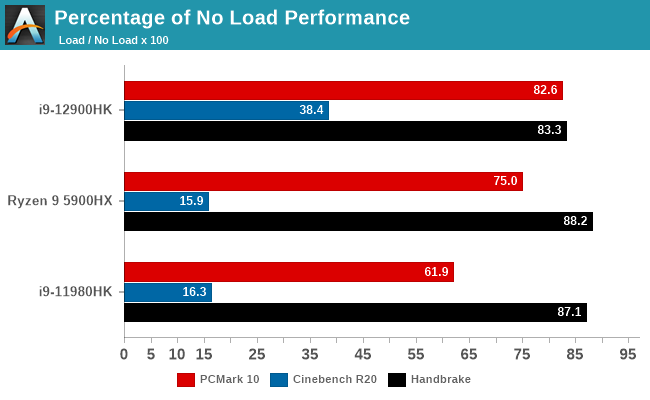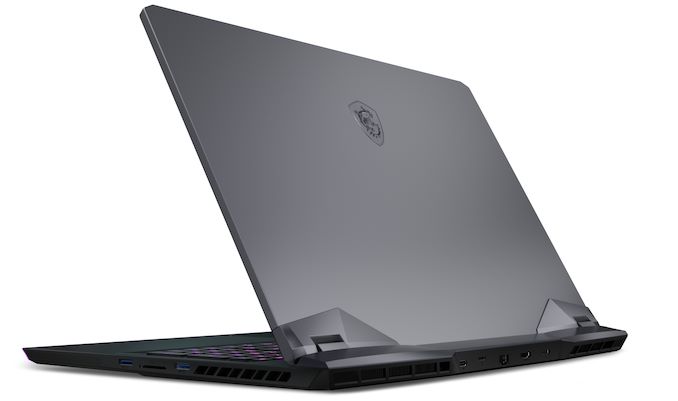Intel Alder Lake-H Core i9-12900HK Review: MSI's Raider GE76 Goes Hybrid
by Brett Howse on January 25, 2022 9:00 AM EST- Posted in
- CPUs
- Intel
- MSI
- Laptops
- Alder Lake
- GE76 Raider
- 12th Gen Core
- Alder Lake-H
Initial Thoughts
Intel has been consistent over the last several years to bring their low-power processors to market first, and then move towards the higher-performance platforms and desktops. With the laptop market being the majority of sales, this has made a lot of sense, but it most certainly has left the desktop crowd at a disadvantage. With Alder Lake, Intel has flipped that around completely by launching the desktop products first, and are now just moving down to high-performance laptops, and then finally low-power notebooks. The Core i9-12900HK at the heart of the MSI Raider GE76 is our first taste of Alder Lake in a portable system, and it tastes delicious.
The new hybrid CPU design delivers in multiple ways. Outright performance easily exceeds everything else on the market. The new Golden Cove P-Cores offer a significant uplift in terms of instructions-per-clock (IPC) and allow Intel to regain the single-thread performance crown. Having twenty threads available in a laptop processor also gives Intel the multi-threaded performance lead.
Perhaps the most impressive result though is Intel’s Thread Director, which provides very impressive system responsiveness even when the system is at 100% CPU load. Tasks that are being done in the background are still done quickly, but no longer at the expense of the user, and without having to manually adjust thread priority. This is a major win.

The supplied MSI Raider GE76 with the i9-12900HK and GeForce RTX 3080 Ti for Laptops also showcased increased gaming performance, although the increases were more subtle than the system performance results. At 1920x1080, the Alder Lake system almost universally provided a reasonable uptick in gaming performance, although the 3080L Ti GPU did not significantly move the yardstick at UHD resolutions.
Intel has also been able to integrate the CPU and chipset into one package for the 12th generation H-Series processors, and that System-on-Chip provides a lot of connectivity and expansion options, as well as compatibility with four different memory choices in DDR4, DDR5, LPDDR4, and LPDDR5. There is support for four Thunderbolt 4 controllers, as well as two by four lanes of PCIe 4.0 for storage, and another eight lanes for graphics and an additional twelve lanes of PCIe 3.0. Intel now also includes Iris Xe-LP graphics in their H-Series, with the full 96 Execution Units on tap with the Core i9-12900HK.
The one downside from sampling the MSI Raider GE76 was that it's a laptop designed to show off Alder Lake at its best with regards to performance, but at the expense of more mobile-friendly matters such as portability, energy efficiency, and battery life. Case in point: despite having the largest possible battery allowed in a notebook at 99.9 Wh, the base system power draw of the Raider was significant, making battery life poor and masking any changes that would have been a result of the CPU. Intel is aiming Alder Lake-H at everything from luggable desktop replacements such as the Raider to 14-inch ultraportable laptops, so there is a second side to Alder Lake that we've still yet to see. Once more laptops start shipping – especially the U-Series with LPDDR5 – we should get a much better feel for how the hybrid CPU design does when the device is running off the battery.
Thankfully, the lack of battery life was really the only negative for the MSI Raider GE76. It offers plenty of cooling, a great display, and offers the most potent laptop GPU on the market. The Tiger Lake version was the quickest laptop we had tested, but the new Alder Lake one takes things to another level. It is simply one of the best gaming notebooks on the market right now, and it's easy to see why Intel picked this laptop to show off the performance capabilities of Alder Lake-H.
Alder Lake appears to be a significant step forward for Intel, with commanding single-threaded performance, exceptional multi-threaded performance, and the benefits of Thread Director to increase system responsiveness. Alder Lake was a step forward for desktops, but likely an even larger step forward for notebook computers. Intel has delivered tremendous performance across the board and the gap is not even close. 2022 is shaping up to be an exciting year again.












153 Comments
View All Comments
Kamen Rider Blade - Tuesday, January 25, 2022 - link
So the ASUS G513QY w/ it's Ryzen 9 5900HX + Radeon 6800M + It's display / Memory don't also impact power consumption?That the ASUS that you chose wasn't similar enough?
Brett Howse - Tuesday, January 25, 2022 - link
Of course they do. AMD does way better on battery life but not because of the CPU. That's the point I've been trying to convey.AMD's power gating on their GPU is very impressive.
You said Alder Lake is "max performance with no regards to Fuel/Energy Efficiency" but in both the AMD system and the Intel system, neither CPU is the determining factor for battery life. They are almost irrelevant. Even in a thin and light system with no GPU, the display draws more power than any other component including the CPU.
I would love an apples to apples comparison but I don't have a Raider GE76 with RTX 3080 Ti and Ryzen 5900HX. Sadly we are constrained by what we have been provided to test, and what manufacturers build.
Kamen Rider Blade - Tuesday, January 25, 2022 - link
=(Kamen Rider Blade - Tuesday, January 25, 2022 - link
MSI Raider GE76CPU = Intel Core i9-12900HK w/ 85 Watts TDP
GPU = NVIDIA RTX 3080 Ti for Laptops
RAM = 32 GB DDR5-4800
Display = 17.3" 2K | 1080p @ 360 Hz
Battery = 99.9 Wh
Asus ROG Strix G15 G513QY
CPU = AMD Ryzen 9 5900HX __ w/ 45 Watts TDP
GPU = AMD Radeon RX 6800M
RAM = 16 GB DDR4-3200
Display = 15.6" 2K | 1080p @ 300 Hz
Battery = 90.0 Wh
IntelUser2000 - Wednesday, January 26, 2022 - link
5900HX in the G15 isn't running at 45W, that's his whole point, but either you are choosing to ignore it or didn't see it."The ASUS G513QY with the AMD Ryzen 9 5900HX has a similar system, and it also draws around 85 Watts in its maximum performance mode on a 45-Watt processor."
That's the *same* power as Alderlake-H.
undervolted_dc - Wednesday, January 26, 2022 - link
alder lake it's not at maximum performance mode 85w, it's 115w a good test should account for power and price, a cpu which cost 2x because it's the super top 1% binning for 10% median better perf in benchmarks or that consume 2x for the same should be accounted in each bench results, top performance is a factor but the most important one for laptops are perf/watt/price and for servers is perf/TCO , perf alone is useless ( or useful to reach a certain wanted point from the press.... )Kamen Rider Blade - Tuesday, January 25, 2022 - link
The specs are similar enough, the only difference is that extra 1.7" display diagonal and extra 16 GB of RAM, but MSI has the more efficient DDR5 instead of older DDR4.MSI also has an extra 9.9 Wh to it's advantage.
Yet the AlderLake laptop was "UnImpressive"
jjjag - Wednesday, January 26, 2022 - link
Brett you are hilarious trying to reason with a fanboi. It's like trying to convince a trumper to get vaxxed because of all the past success we've had with smallpox and polio. For them, it's a religious argument. "Religious" because it ignores all real data and observations, and it just makes them feel better about themselves to hate something. But A+ for trying!TheinsanegamerN - Friday, January 28, 2022 - link
Funny, I didnt know the black community was full of trumpers. Or the hispanic community, for that matter......Sunrise089 - Wednesday, January 26, 2022 - link
But Brett, you’re giving the Intel system credit for the GPU+memory+storage. I don’t understand the rationale behind crediting the PCMark scores to Alder Lake but ‘crediting’ the poor battery life to MSI.